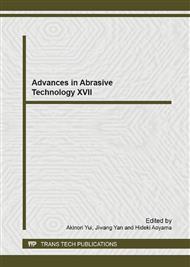p.373
p.377
p.383
p.389
p.393
p.399
p.406
p.411
p.417
An Innovative Cooling Method for Grinding Process Based on Heat Pipe Technology
Abstract:
The core idea of the existing cooling methods in grinding process is making a large quantity of coolant into the contact zone. However, the practical quantity of coolant injected in the grinding zone is limited, and the large amount of coolant employed can cause pernicious effect to human health and the environment, and will largely increase the expenses. In order to solve this problem, an environmental friendly idea about enhancing heat transfer in the contact zone based on heat pipe technology is put forward in this paper. The new system, heat pipe grinding wheel (HPGW), based on this high-efficiency cooling technology is developed and its heat transfer principle is illustrated. Eventually grinding experiments with HPGW were carried out to verify the cooling effect by comparing with non-HPGW in grinding plain carbon steel. Results show that using HPGW can significantly reduce the grinding temperature with no coolant.
Info:
Periodical:
Pages:
393-398
Citation:
Online since:
September 2014
Authors:
Price:
Сopyright:
© 2014 Trans Tech Publications Ltd. All Rights Reserved
Share:
Citation:


